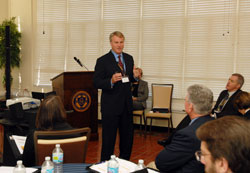2012 Catholic Schools Week Supplement
First education summit marks new era for Catholic schools

Marian University president Daniel Elsener makes a point during an education summit that involved educational leaders from Indiana’s five dioceses. The summit was held on Nov. 29-30 at the Indianapolis college. (Submitted photo)
By John Shaughnessy
It was a defining moment for Catholic education in Indiana—a moment when the issues of the Indiana school voucher program, the future of Catholic schools in the state and the importance of Catholic identity in schools were addressed in a historic education summit.
For the first time, educational leaders from the state’s five dioceses met at an education summit to discuss the different ways they can collaborate to make Catholic education even stronger statewide.
When the two-day summit at Marian University in Indianapolis ended, education leaders from the five dioceses—Evansville, Gary, Indianapolis, Lafayette and Fort Wayne-South Bend—had established the groundwork for a new marketing campaign and several other initiatives that could “allow even more students to experience the great, quality Catholic education.”
“We all have the same mission in the state of Indiana,” said Kathy Mears, an assistant superintendent of schools for the Archdiocese of Indianapolis, who wrote the executive summary of the Catholic Education Summit 2011 that was held on Nov. 29-30. “We haven’t been maximizing, through collaboration and cooperation, all the gifts we’ve been given. With this approach, the possibilities are endless.”
A main factor that led to the summit was the Indiana school voucher program that became law on July 1, 2011—a program that offers state-funded, financial assistance to families of certain income levels to help them select a school of their choice for their children. (For information about the program and how to apply, see pages 7B and 10B in this supplement.)
While the voucher program connects the school systems of the five dioceses even more and offers opportunities for increased enrollment, it also creates the challenge that the Catholic identity of these schools is not lost as they “become more involved in the educational reform movement in Indiana,” Mears noted.
“We want to make sure our faith is integrated into the standards of what we teach,” Mears said. “If we’re going to teach about the civil rights movement, in addition to talking about Dr. Martin Luther King Jr., we’ll talk about Cardinal [Joseph E.] Ritter and how he integrated Catholic schools in Indianapolis 15 years before Brown v. Board of Education. In Biology, we’ll talk about the sanctity of life.”
Another challenge is to continue to develop teachers and administrators who can teach the faith and lead students to academic excellence—while also finding ways to better compensate those Catholic educators.
“The gap between a Catholic school teacher’s pay and a public school teacher’s pay continues to widen,” Mears said. “I don’t think the average parent knows the difference in compensation. We’re looking at different compensation models.”
Holding the first summit at Marian University also showcased the benefits and possibilities of connecting Catholic elementary schools and high schools to nearby Catholic colleges.
“The state of Indiana talks about
P-12 education [preschool to 12th grade],” Mears said. “We think it needs to be P-16. There’s expertise at the college level that we can use. I believe other Catholic universities will come on board for the next summit.”
The summit has already led the school systems of the five dioceses to embrace the same marketing theme that will be used by Catholic schools in Indiana—“Catholic Schools: The Good News.”
“We hope it comes to mean Catholic education in Indiana,” Mears said. “The Good News means the Gospel, which is our evangelization. The Good News also means Catholic schools are good for kids.”
Plans to continue the education summit among the five dioceses are also good news for the future of Catholic education in Indiana, according to Mears.
“I think the summits will help make our Catholic schools strong and viable,” she said. “Together, we’re going to consider a lot more ideas than we did before. The result will be that we Catholics will come together in communion and community to develop our students into faith-filled adults. That’s the real goal.” †
